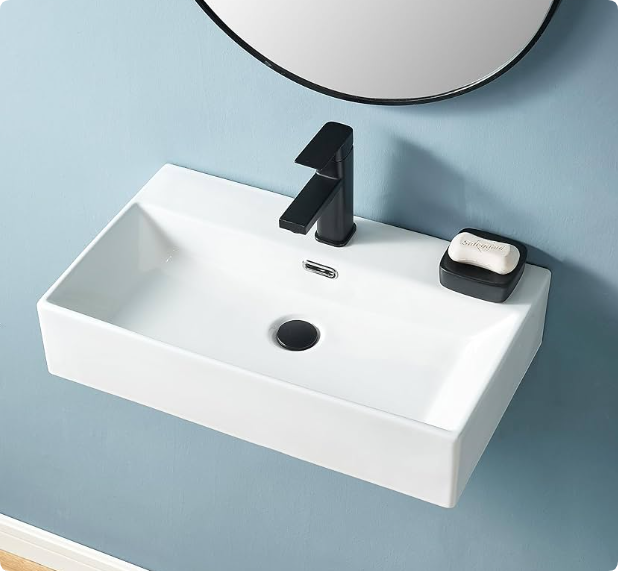Wall-hung sinks have become a popular choice in modern bathroom designs, thanks to their sleek look and space-saving functionality. However, a common concern for many potential buyers and installers is safety. Are these sinks truly safe? What factors influence their durability and security? This comprehensive guide will address these questions, ensuring you have all the information needed to make an informed decision.
Table of Contents
What Is a Wall-Hung Sink?
A wall-hung sink is a basin that is mounted directly onto a bathroom wall without the support of a pedestal or vanity. These sinks are especially favored in small bathrooms or minimalist designs due to their clean aesthetic and ability to free up floor space.

Key Features of Wall-Hung Sinks:
- Space-saving: Ideal for small bathrooms.
- Modern design: Adds a contemporary flair.
- Customizable height: Can be installed at a height suited to the user.
- Easy cleaning: No pedestal or cabinet obstructing access to the floor.
Are Wall-Hung Sinks Safe?
The short answer is yes, wall-hung sinks are safe when installed correctly. However, their safety depends on several factors, including installation quality, weight capacity, and materials.
Plumbing Code Regulations – Information on plumbing codes and standards.

Factors Affecting the Safety of Wall-Hung Sinks
| Factor | Why It Matters | How to Ensure Safety |
|---|---|---|
| Wall Strength | A weak wall cannot support the weight of the sink, leading to potential accidents. | Install on reinforced walls, such as those made of concrete or walls with proper stud framing. |
| Mounting Hardware | Low-quality brackets or bolts may fail under the sink’s weight or over time. | Use heavy-duty brackets rated for the sink’s weight, and ensure all hardware is securely fixed. |
| Sink Material | Heavier materials like ceramic or stone require stronger support compared to lightweight materials. | Choose a sink material that balances durability and weight, and ensure the mounting system is compatible. |
| Weight Capacity | Overloading the sink by placing heavy objects can strain the mounting system. | Avoid placing excessive weight on the sink, and check the manufacturer’s specifications for weight limits. |
| Professional Installation | Incorrect installation can lead to wobbly sinks or even accidents. | Hire a certified plumber or contractor experienced in installing wall-hung fixtures. |
The Role of Wall Strength in Sink Safety
Drywall vs. Concrete Walls:
Wall-hung sinks are not universally suited for all wall types. For instance:
- Drywall: Requires additional reinforcement, such as installing a plywood backing or attaching the sink to wall studs.
- Concrete/Brick Walls: Naturally strong and can support heavier sinks without additional modifications.
Testing Wall Integrity:
Before installing a wall-hung sink, it’s essential to assess the wall’s load-bearing capacity. Professional contractors often use stud finders or load calculators to determine the feasibility of installation.
How to Ensure Safe Installation of a Wall-Hung Sink
- Select the Right Sink: Choose a sink designed for wall mounting with clear weight specifications.
- Reinforce the Wall: If the wall isn’t strong enough, install reinforcements such as a wooden or metal backing.
- Use High-Quality Mounting Hardware: Invest in brackets and bolts specifically designed for the chosen sink model.
- Follow Manufacturer Guidelines: Adhere to the installation instructions provided by the sink manufacturer.
- Hire Professionals: While DIY installation is tempting, hiring a professional ensures compliance with safety standards.
Install A Sink | Wall Mount Sink (3 Minute Guide)
Benefits of Wall-Hung Sinks Beyond Safety
Despite concerns, wall-hung sinks offer numerous advantages that make them a top choice for modern bathrooms.
1. Enhanced Accessibility
Wall-hung sinks can be installed at varying heights, making them suitable for users with mobility challenges or those designing ADA-compliant bathrooms.
2. Aesthetic Appeal
The floating design creates an illusion of more space, making bathrooms appear larger and more open.
3. Easy Maintenance
With no pedestal or cabinet obstructing access, cleaning the sink and surrounding areas becomes much easier.
Guide to Reinforcing Walls for Heavy Fixtures – Tips on preparing walls for heavy installations.
Common Misconceptions About Wall-Hung Sinks
1. They’re Not Strong Enough
Modern wall-hung sinks are engineered to support significant weight when installed correctly. Reinforced brackets and sturdy walls ensure their durability.
2. They’re Difficult to Install
While the installation requires proper planning, it is straightforward with professional help. Clear guidelines from manufacturers make the process manageable.
3. They’re Only for Small Bathrooms
Although they’re popular in compact spaces, wall-hung sinks are equally suited for larger bathrooms seeking a contemporary design.
FAQs About Wall-Hung Sink Safety
Q: Can wall-hung sinks support heavy usage?
Yes, most wall-hung sinks are designed to handle regular usage. Always check the manufacturer’s weight capacity.
Q: What is the lifespan of a wall-hung sink?
With proper installation and maintenance, a wall-hung sink can last decades.
Q: Are wall-hung sinks safe for families with children?
Yes, but extra precautions, such as child-proofing or reinforced installations, can add an additional layer of safety.
Conclusion: Are Wall-Hung Sinks Safe?
Wall-hung sinks are safe when installed and maintained correctly. By understanding the factors affecting their safety and following best practices, homeowners and businesses can enjoy the aesthetic and functional benefits of these modern fixtures.
For those still uncertain, consulting a professional plumber or contractor is the best way to ensure a secure and durable installation.
